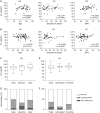The association between serum zinc level and clinical features in patients with inflammatory bowel disease
- PMID: 39896166
- PMCID: PMC11782769
- DOI: 10.3164/jcbn.24-64
The association between serum zinc level and clinical features in patients with inflammatory bowel disease
Abstract
Zinc is an essential element and important for inflammatory bowel disease patients. Herein, we aimed to elucidate the correlation between serum zinc concentration and various parameters, especially the disease activity index and endoscopic scores, in these patients. We measured serum zinc concentrations in 37 patients with Crohn's disease and 64 with ulcerative colitis and retrospectively analyzed patient characteristics, blood test values, disease activity, and endoscopic scores. Hypozincemia (<80 μg/dl) was observed in 45.9% and 29.7% of patients with Crohn's disease and ulcerative colitis, respectively. Serum zinc concentration showed a weak negative correlation with Crohn's Disease Activity Index and C-reactive protein levels in Crohn's disease patients, and a weak negative correlation with white blood cell count in ulcerative colitis patients. The zinc concentrations in ulcerative colitis patients were significantly lower in Mayo endoscopic sub-score grade 2 than in grades 0 and 1. The simple endoscopic score for Crohn's disease moderately correlated with zinc concentration. In addition, serum zinc concentration showed a moderate correlation with serum albumin and Onodera's prognostic nutritional index in both Crohn's disease and ulcerative colitis patients. Serum zinc concentration clearly correlated with inflammatory bowel disease activity, endoscopy scores, and immunonutritional parameters, suggesting the importance of monitoring zinc levels.
Keywords: Crohn’s disease; disease activity; hypozincemia; ulcerative colitis; zinc.
Copyright © 2025 JCBN.
Conflict of interest statement
No potential conflicts of interest were disclosed.
Figures





References
-
- Lin A, Micic D. Nutrition considerations in inflammatory bowel disease. Nutr Clin Pract 2021; 36: 298–311. - PubMed
-
- Spooren CEGM, Wintjens DSJ, de Jong MJ, et al. Risk of impaired nutritional status and flare occurrence in IBD outpatients. Dig Liver Dis 2019; 51: 1265–1269. - PubMed
-
- Stokes MA. Crohn’s disease and nutrition. Br J Surg 1992; 79: 391–394. - PubMed
LinkOut - more resources
Full Text Sources
Research Materials

